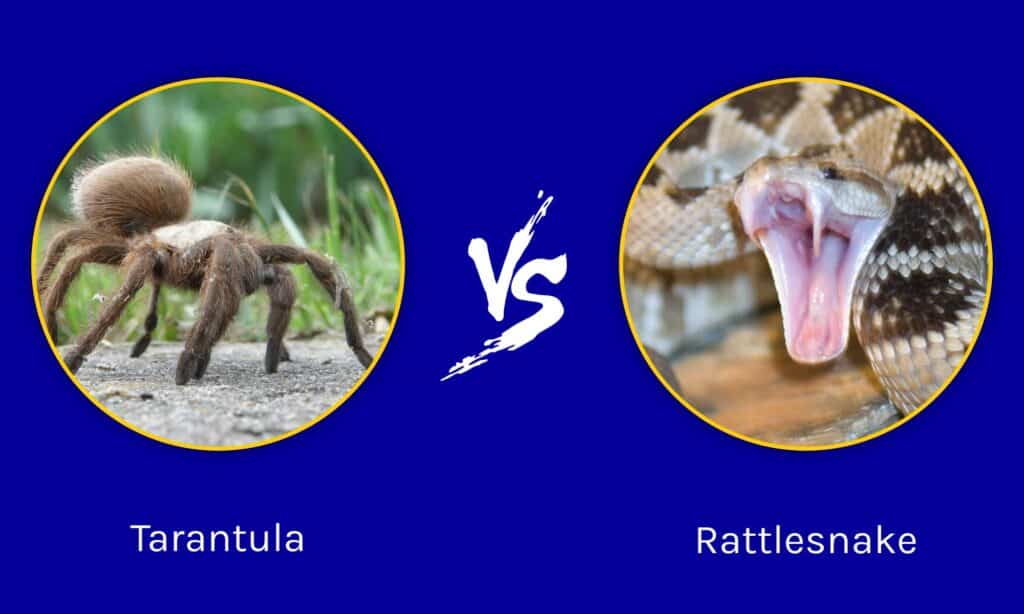Tarantulas are spiders from the Theraphosidae family. They are common in the United States, Central and South America, and Mexico. Tarantulas can also be found in Africa, Australia, Asia, and some parts of Europe. Rattlesnakes are a venomous snake species, members of the Viperidae family. The key characteristic that helps distinguish them from other snakes is the rattle at the end of their tail. All the rattlesnake species and subspecies are native to North America and South America. The United States hosts the largest species of rattlesnake.
How can a tarantula eat such a large species of reptile? However, let’s analyze and compare the hunting skills, speed, defense techniques, and venom of a tarantula and that of a rattlesnake.
Spider vs Snake: Who would win?

While other spiders rely on their webs, tarantulas rely on their hunting skills.
©Milan Zygmunt/Shutterstock.com
Before moving on to specific details about tarantulas and rattlesnakes, let us tell you that the likelihood of a spider killing a snake is not as low as you’d think! A study shows that scientists were surprised at how common this was! Moreover, they’ve found snakes eaten by spiders on all the continents except Antarctica. Over 40 species of spiders were reported to kill and feed on snakes. And guess what? Tarantulas are one of the species that are more likely to kill a snake. While other spiders rely on their webs, tarantulas rely on their hunting skills.
Therefore, it becomes even more interesting to figure out whether a tarantula or a rattlesnake would win in a fight since both of them are extremely skilled predators!
Key Factors in a Fight between a Tarantula and a Rattlesnake

Size, speed, mode of attack, and venom are critical factors that would determine who would eat each other between a tarantula and a rattlesnake. Each of them has its advantages, and we will be exploring them below before we can arrive at a conclusion.
Tarantula vs Rattlesnake: size and speed

The average tarantula weighs 3 ounces.
©Milan Zygmunt/Shutterstock.com
Tarantulas are fairly big spiders. Their body can measure up to 5 inches and up to 12 inches with leg spans. The average tarantula weighs 3 ounces. However, the biggest tarantula in the world, the Goliath Birdeater, weighs 6 ounces. A rattlesnake’s average length is about 2.5 to 5 feet long, but some can measure up to 7 feet long. Rattlesnakes weigh up to 10 pounds. A rattlesnake is considerably bigger than a tarantula.
When it comes to speed, the tarantula is the second-fastest spider in the world, right after the Giant House Spider. The average speed of a tarantula is between 8.4 inches and 21 inches per second. They usually run in short bursts. Tarantulas won’t often run more than 15 inches per second. They will take the risk only if they’ve not eaten and if the ground is favorable.
The average running speed of all rattlesnake species is between 2 and 3 miles per hour. However, some species of rattlesnakes made it to the top of the fastest snakes in the world. The Eastern diamondback rattlesnake has a striking speed of 2.95 meters per second. The Sidewinder, also known as the horned rattlesnake, is the world’s fastest-moving snake and has a ground speed of 18 miles per hour. Just like tarantulas, they run in short bursts.
Rattlesnakes have a size and speed advantage.
Tarantula vs Rattlesnake: Hunting skills

Rattlesnakes rely mostly on their eyesight and a strong sense of smell.
©iStock.com/johnaudrey
Rattlesnakes rely mostly on their eyesight and a strong sense of smell. The heat-sensing pits near the tip of their nose alarm them when warm-blooded animals are nearby. Rattlesnakes don’t hear too well. They can only sense the vibrations in the ground.
Tarantulas are also sensitive to the vibrations in the ground. However, they have poor eyesight and rely on their sense of touch. The hairs on their body and legs are sensitive to the environment and movements around them.
Numerous species of tarantulas have extremely sharp mouth pincers that give them the possibility to puncture the exoskeletons of numerous insects and arachnids. A tarantula with mouth pincers may even puncture the hard exoskeleton of a scorpion. So a rattlesnake shouldn’t be a problem if a tarantula catches it. However, since rattlesnakes are much faster, the mouth pincers will only be of help if the tarantula has a more favorable situation during hunting.
When it comes to hunting skills, the tarantula and the rattlesnake have, more or less, equal advantages, depending on the circumstances.
Tarantula vs Rattlesnake: Method of Attack

A rattlesnake’s attack method involves biting the spider and waiting until it gives up and dies.
©iStock.com/Wide-River-Rick
A rattlesnake’s attack method involves biting the spider and waiting until it gives up and dies. This is a disadvantage for a venomous snake if the spider is small because it would be extremely hard to catch it. If we’re talking about a tarantula that can sometimes measure 12 inches long, the rattlesnake has a better chance.
Tarantulas have a slightly different tactic. They jump on the rattlesnake’s head, pierce its skin, and release the venom. If they fail to attack the rattlesnake on its head, they risk being bitten back because the rattlesnake won’t just sit around waiting to die!
Tarantula’s attack skills are more favorable.
Tarantula vs Rattlesnake: Venom

A tarantula’s venom consists of substances meant to paralyze the prey quickly.
©True Touch Lifestyle/Shutterstock.com
A rattlesnake’s venom is a mixture of chemical elements that cause hemorrhaging, necrosis, and sometimes paralysis. The toxins start damaging the blood vessels and tissues when the venom reaches the prey’s body.
A tarantula’s venom consists of substances meant to paralyze the prey quickly. These substances dissolve and liquefy the prey’s flesh so that the tarantula can suck the liquid up.
Both the tarantula and the rattlesnake have powerful venom.
Tarantula vs Rattlesnake: Who would eat who?
A tarantula would win the fight against a rattlesnake. At first, this might seem unlikely. A rattlesnake is bigger, so the chances are higher for it to kill a tarantula, right? But in fact, the tarantula’s characteristics make it more likely to win. Even though the rattlesnake is bigger and faster, the tarantula’s hunting skills counterbalance the fact that it is slower than the rattlesnake.
The tarantula’s hunting techniques are a clear advantage. It can quickly ambush the rattlesnake, biting it by the head. The rattlesnake, in turn, can’t do anything to escape.
We’re not talking about a fight when talking about a tarantula and a rattlesnake. We’re talking about a single move that either kills the tarantula or the rattlesnake. So who eats who is determined by how the two come across each other, who sees or senses who first, and how quickly they react.
The photo featured at the top of this post is © Milan Zygmunt/Shutterstock.com
Thank you for reading! Have some feedback for us? Contact the AZ Animals editorial team.






